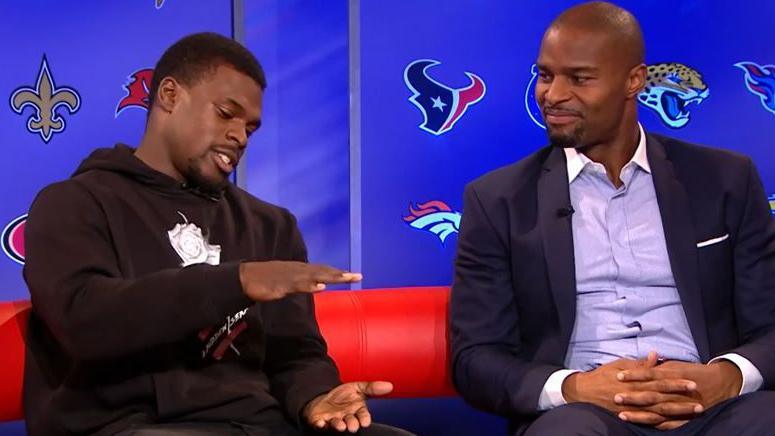To play this video you need to enable JavaScript in your browser.
- 56 Comments
The odds were stacked against Louis Rees-Zammit as he aimed to establish himself in the NFL.
And, after spending 18 months chasing his NFL dream, the Welsh star decided last week that the time was right to return to rugby.
The 24-year-old is the latest ‘crossover athlete’ unable to make the transition from another sport, most of them from rugby.
‘Playbooks are tougher to learn than law books’
Any NFL players who have come through the North American education system have grown up with American football and had years to grasp the intricacies and nuances of the sport.
Osi Umenyiora and Efe Obada are two of those who have been born overseas and proved it is possible to pick up the game late and still succeed, but you must be able to understand a playbook.
Christian Scotland-Williamson played rugby union either side of a two-year stint on the Pittsburgh Steelers’ practice squad and has since become a barrister.
During a video call with BBC Sport, the 32-year-old held up two law books – each more than an inch thick – and said: “Learning both of these was easier than learning an NFL playbook, which is absolutely absurd.
“Doing all that [legal training], I still wasn’t working as hard as I had to when I went to the NFL. It recalibrates what you think is hard.”
Speaking to the BBC after beginning his NFL journey in 2018, Christian Wade held his hands several inches apart and said “the playbook’s like this”.
“It is quite intimidating but there’s a method to it,” he added. “You have to learn the terminology and how to dissect it so that you can retain the information, then in a few hours put that into practice. Then do the same in the afternoon and the next day.”
‘You have to be unparalleled to break through’
Even if you can process a playbook, two-time Super Bowl winner Umenyiora points to something called the ‘planet theory’ as a major obstacle for NFL hopefuls like Rees-Zammit.
Espoused by late New York Giants general manager George Young and their legendary head coach Bill Parcells, the theory states there are only a few humans on the planet who have the ideal size and athleticism to succeed as offensive and defensive linemen, thereby making them more valuable.
The opposite is true at running back and wide receiver, which along with quarterback and tight end are considered American football’s ‘skill positions’.
They are the positions Rees-Zammit tried his hand at and, after last week’s decision, he mentioned how so many similar players were competing for a spot on the active roster.
“I think Rees-Zammit is a fantastic athlete, but in terms of pace and athleticism, there’s maybe 500 of those guys in Florida alone, so it’s usually a lot more difficult for players like that,” said Umenyiora.
“You have to be unparalleled. You have to be superior athletically to be able to learn the game and then break through.”
Rees-Zammit is one of the fastest players in world rugby, he registered 4.43 seconds for the 40-yard dash but that put him just joint-27th among the players eligible for last year’s NFL Draft.
But even if he was the quickest, players new to the NFL need time to catch up on the “football IQ” their rivals have already developed, says pundit Phoebe Schecter.
“The key factor is the ability to take what’s learned in the classroom and apply it at elite speed on the field because players can overthink it, there can be paralysis by analysis,” she added.
Hard work key to Mailata’s success
To play this video you need to enable JavaScript in your browser.
Umenyiora and Obada were both defensive linemen, while Jordan Mailata is an offensive lineman who is 6ft 8in and weighs 365lbs (26st).
The former rugby league player had not played American football when he was drafted in 2018 by the Philadelphia Eagles, who no doubt had ‘planet theory’ in mind having already seen that he has athleticism to go with his size.
“There’s just not that many people on the planet like him,” said Umenyiora.
“It’s all supply and demand really. The supply of that type of athlete is very low and the demand very high, so [NFL teams] give them every chance to succeed.
“When you get a guy like that, people tend to give him more specialised attention [than players like Rees-Zammit] because he’s playing a premium position in the NFL.”
As a left tackle, Mailata is responsible for protecting the quarterback’s blind side – if they are right-handed – but it was not an immediate transition.
After learning the basics through the NFL’s International Player Pathway, he spent two seasons on the Eagles’ practice squad before playing his first game in 2020.
And British coach Aden Durde, who started the IPP programme with Umenyiora and is now the Seattle Seahawks’ defensive coordinator, stressed that Mailata’s success is not just down to his genes.
“He has a set of skills, is very resilient and very smart,” said Durde. “He learned how to develop in the sport and what he’s good at – the ability to pass protect.
To play this video you need to enable JavaScript in your browser.
The Buffalo Bills hope that Travis Clayton develops the same way after making the 6ft 7in former rugby union player the second IPP athlete to be drafted last year, while there are an increasing number of Australian and Irish kickers and punters in the NFL.
Having grown up playing Australian rules and Gaelic football, they have already honed their kicking skills, and as they only take the field in kicking scenarios, the gap in game knowledge is much easier for them to bridge.
Related topics
- American Football
Source: BBC

Leave a Reply